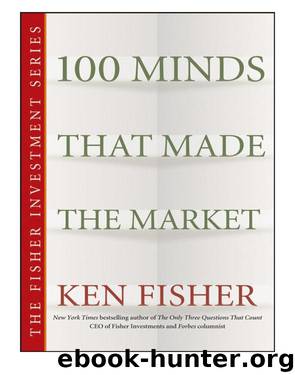100 Minds That Made the Market by Kenneth L. Fisher

Author:Kenneth L. Fisher
Language: eng
Format: epub
Publisher: Wiley
Published: 2010-05-19T04:00:00+00:00
E.H.H. SIMMONS
ONE OF THE SEEDS OF TOO MUCH GOVERNMENT
The stringent federal regulations that bombarded Wall Street and left crooked opportunists reeling in the 1930s were partially the result of an ambitious antifraud campaign initiated by E.H.H. Simmons. During a record-breaking six-year presidency of the New York Stock Exchange (NYSE) between 1924 and 1930, Simmons crusaded for a new, more trustworthy Wall Street to replace the old one, which had included unscrupulous speculators, swindlers, and fly-by-night bucket shops.
The nephew of straight shooting railroader E.H. Harriman (from whom Simmons got his initials), Simmons firmly believed that Wall Street was no longer able to clean its own house and that to protect the American economy, he and Uncle Sam first had to protect its investors. He advocated, “Crooked business is the worst enemy honest business has.” It was a heartfelt view, if a naive one.
“If I could reach all the investors of America—and who is not an investor nowadays?—I would try to impress upon them the menace of the bucket-shop keeper and the security swindler,” he wrote in a typical, heartfelt editorial in 1925. In his first year as president, the private and moral-minded Simmons recruited Chambers of Commerce and newspaper editors nationwide to help him inform the uniformed investor of the typical swindler’s actions. He himself wrote articles, gave speeches, and courted politicians, advocating stricter laws and stricter enforcement. Too often, he said, politics played a role in acquitting popular stock market criminals of crimes.
Simmons aimed much of his attack at bucket shops, which gave investors virtually no chance of winning profits, yet had been accepted by society as a virtual institution. Wild plunger Jesse Livermore made his first million via bucket shops in the early 1900s, but he was the rare exception—most folks lost heavily. (See Livermore for a more detailed description of bucket shops.) Simmons called the buckets “a civic, moral and economic cancer” that went undetected. Bucket shops were so common and entrenched in society back then—like off track betting is now—that people and law enforcement officials seldom saw them as a menace. And although Simmons carried on about them for a good decade, it wasn’t until 1934 that the Securities Exchange Act outlawed them.
Fake stock promoters—like those selling stock in phony gold mines and underwater Florida land—also got the boot from Simmons. He worked with state and federal authorities to eliminate such crooks and boldly encouraged fellow stock market members to turn in suspicious colleagues. “The honor of the institution and the honor of its members must be maintained at all times. That can best be done by obeying and conforming to the rules of the Exchange,” he declared.
Simmons was basically your average old-fashioned policeman who liked to see justice served and who happened to work on Wall Street. He was born in Jersey City, New Jersey, graduated from Columbia in 1898 and bought a stock exchange seat in 1900. He became a partner in a brokerage firm, Rutter & Cross, and became a governor on the exchange in 1909.
Download
This site does not store any files on its server. We only index and link to content provided by other sites. Please contact the content providers to delete copyright contents if any and email us, we'll remove relevant links or contents immediately.
Zero to IPO: Over $1 Trillion of Actionable Advice from the World's Most Successful Entrepreneurs by Frederic Kerrest(4076)
Machine Learning at Scale with H2O by Gregory Keys | David Whiting(3666)
Harry Potter and the Goblet Of Fire by J.K. Rowling(3619)
Never by Ken Follett(3550)
Ogilvy on Advertising by David Ogilvy(3353)
Shadow of Night by Deborah Harkness(3184)
The Man Who Died Twice by Richard Osman(2824)
Book of Life by Deborah Harkness(2727)
My Brilliant Friend by Elena Ferrante(2707)
How Proust Can Change Your Life by Alain De Botton(2621)
0041152001443424520 .pdf by Unknown(2612)
Will by Will Smith(2595)
The Tipping Point by Malcolm Gladwell(2566)
How to Pay Zero Taxes, 2018 by Jeff A. Schnepper(2508)
Purple Hibiscus by Chimamanda Ngozi Adichie(2504)
Hooked: A Dark, Contemporary Romance (Never After Series) by Emily McIntire(2428)
Rationality by Steven Pinker(2159)
Borders by unknow(2122)
Daughter of Smoke and Bone by Laini Taylor(2086)
